Top Iron Rich Foods to Add in Your Diet to Boost Your Iron Absorption
| Author: Manoja Kalakanti
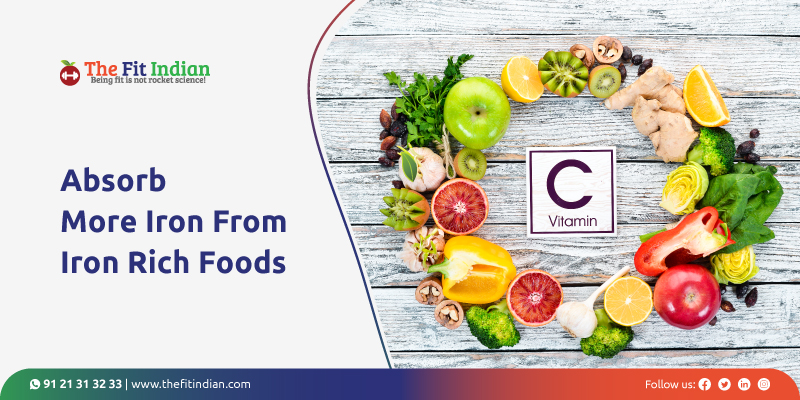 Iron is a nutrient required for many bodily functions, including the formation of hemoglobin in RBC, which carries oxygen from the lungs across the body. While it can store iron, it cannot produce it. Iron can only be obtained from foods rich in iron content.
Iron is a nutrient required for many bodily functions, including the formation of hemoglobin in RBC, which carries oxygen from the lungs across the body. While it can store iron, it cannot produce it. Iron can only be obtained from foods rich in iron content.
Foods Rich in Different Types of Iron
Iron is found in foods in two natural forms- Heme Iron
- Non-heme sources.
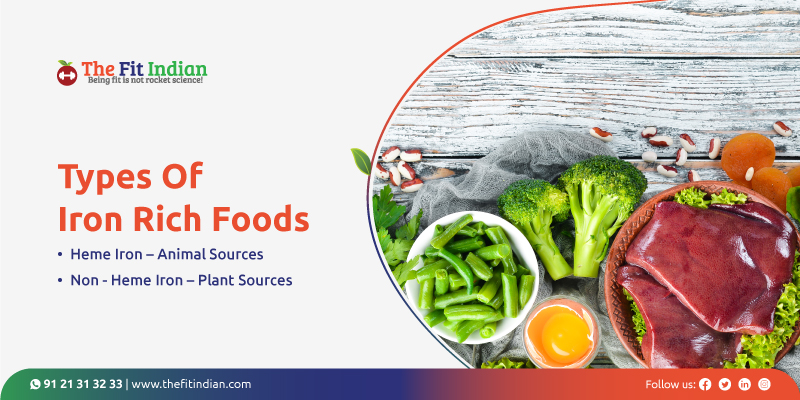
How To Improve Iron Absorption From Food
Are you curious about what aids iron absorption? The body regulates how much iron is absorbed from food and supplements in healthy people, making it challenging to consume ‘too much’ iron.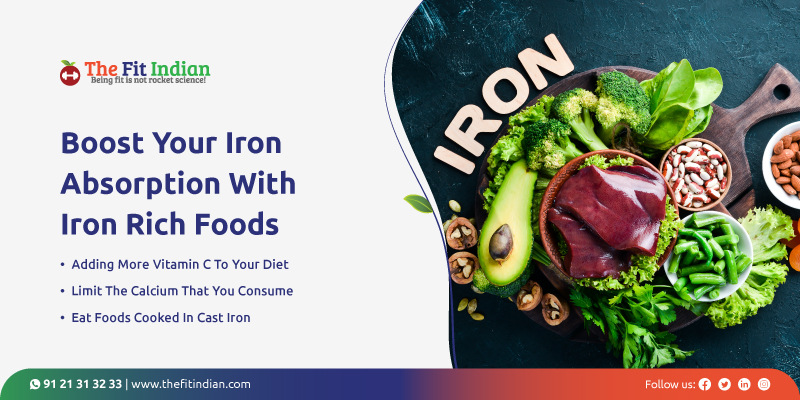 Here are some useful tips:
Here are some useful tips:
Adding More Vitamin C To Your Diet
Include foods high in vitamin C, or ascorbic acid, in the same meal as iron-rich food sources to increase iron absorption. Antioxidants and beta-carotene-rich foods also aid absorption. Among these foods are- Carrots
- Sweet potatoes
- Spinach
- Kale
- Squash
- Red Peppers
- Cantaloupe
- Apricots
- Oranges
- Peaches
Top Foods That Are Rich In Iron
Blood is our body’s lifeline, allowing it to function correctly throughout the day, even when sleeping. Our blood contains two essential components:- Hemoglobin
- Myoglobin
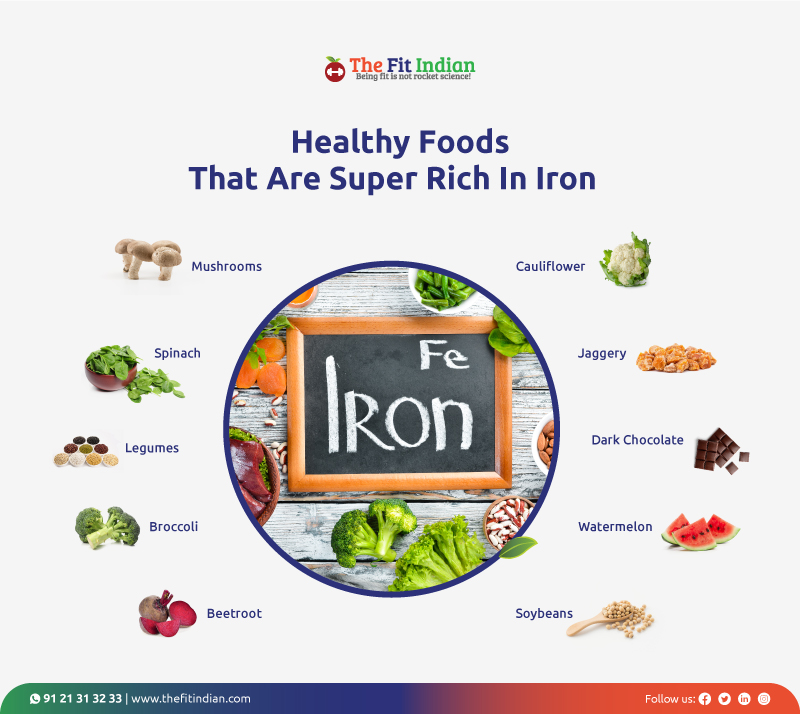 Here are some iron-rich foods for women:
Spinach
You should integrate leafy vegetables like spinach into your diet to improve iron absorption. Spinach contains calcium, vitamin A, and potassium. It contains iron and helps you avoid becoming anemic. Check your intake of leafy vegetables like spinach if you feel weak, tired, or irritated. Because the iron content of raw spinach is easily absorbed, you can eat it either raw or cooked.
Legumes
You cannot compromise on nutritious food as a woman. You can include legumes in your diet daily. To some extent, legumes can be used in place of meat. Because they are soluble fiber, they give not only iron but also aid in hunger suppression. A handful of legumes, such as chickpeas, lentils, and soybeans, can provide enough iron for one day. To increase iron absorption, combine vitamin C-rich foods with legumes.
Broccoli
Broccoli is another iron-rich food that belongs to the cruciferous vegetable family. Not only do they belong to iron-rich foods, but they are also high in magnesium and vitamins A and C. It contains iron, with an estimated 2.7 milligrams of iron per 100gm.
Beetroot
Beetroot, which has a high folate content and is high in iron, is another go-to dietary supplement for increasing hemoglobin levels in our blood. They based their testimony on the fact that they are iron-rich foods to increase hemoglobin levels in the blood.
Mushrooms
Mushrooms have high iron content, with oyster mushrooms having twice the iron concentration. As a result, it alleviates tiredness, vomiting, and headaches caused by iron deficiency. In addition, it also contains potent antioxidant properties, which help the body remove free radicals and prevent certain types of cancer.
Here are some iron-rich foods for women:
Spinach
You should integrate leafy vegetables like spinach into your diet to improve iron absorption. Spinach contains calcium, vitamin A, and potassium. It contains iron and helps you avoid becoming anemic. Check your intake of leafy vegetables like spinach if you feel weak, tired, or irritated. Because the iron content of raw spinach is easily absorbed, you can eat it either raw or cooked.
Legumes
You cannot compromise on nutritious food as a woman. You can include legumes in your diet daily. To some extent, legumes can be used in place of meat. Because they are soluble fiber, they give not only iron but also aid in hunger suppression. A handful of legumes, such as chickpeas, lentils, and soybeans, can provide enough iron for one day. To increase iron absorption, combine vitamin C-rich foods with legumes.
Broccoli
Broccoli is another iron-rich food that belongs to the cruciferous vegetable family. Not only do they belong to iron-rich foods, but they are also high in magnesium and vitamins A and C. It contains iron, with an estimated 2.7 milligrams of iron per 100gm.
Beetroot
Beetroot, which has a high folate content and is high in iron, is another go-to dietary supplement for increasing hemoglobin levels in our blood. They based their testimony on the fact that they are iron-rich foods to increase hemoglobin levels in the blood.
Mushrooms
Mushrooms have high iron content, with oyster mushrooms having twice the iron concentration. As a result, it alleviates tiredness, vomiting, and headaches caused by iron deficiency. In addition, it also contains potent antioxidant properties, which help the body remove free radicals and prevent certain types of cancer.
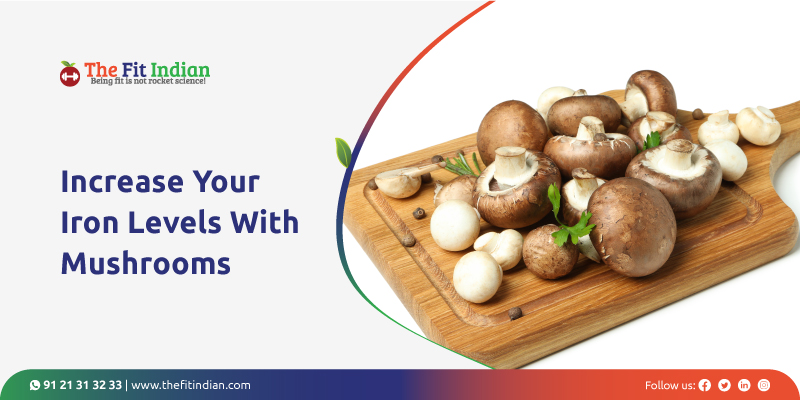 Cauliflower
The green leaves that wrap around the cauliflower are known as cauliflower leaves. The cauliflower leaves are frequently present. These greens are commonly overlooked despite being high in iron and other antioxidants.
Jaggery
Jaggery is high in iron and folate, which provide numerous health benefits. Incorporating jaggery and ginger into your diet allows your body to absorb iron easily. Women should consume a piece of jaggery once a day to alleviate menstrual symptoms such as mood swings, cramps, and abdominal pain. Another advantage of jaggery is that it helps with anemia, which many women suffer from due to a low level of red blood cells.
Dark Chocolate
You can control and treat anemia, a significant health issue many women face. Dark chocolate is high in iron and antioxidants. Antioxidants found in dark chocolate may help to prevent inflammation and heart disease.
Watermelon
This delicious summer fruit contains iron absorption by promoting better iron conversion into hemoglobin. Because of this, watermelon holds a special place among iron-rich foods. It has 0.4 milligrams of iron per cup, allowing it to take its rightful place among iron-containing foods.
Soybeans
Soybeans are one of the best iron-rich foods for vegetarian Indians. A soybean diet improves iron deficiency symptoms by increasing energy, lowering fatigue, and decreasing dizziness. It also increases your energy and physical activity. It is high in protein and iron and can help you gain lean muscle mass quickly.
Almost every dish we eat in India contains iron. Eating iron-fortified foods beats having an iron deficiency, so if you have low iron signs or pernicious anemia, eat iron-fortified foods.
Cauliflower
The green leaves that wrap around the cauliflower are known as cauliflower leaves. The cauliflower leaves are frequently present. These greens are commonly overlooked despite being high in iron and other antioxidants.
Jaggery
Jaggery is high in iron and folate, which provide numerous health benefits. Incorporating jaggery and ginger into your diet allows your body to absorb iron easily. Women should consume a piece of jaggery once a day to alleviate menstrual symptoms such as mood swings, cramps, and abdominal pain. Another advantage of jaggery is that it helps with anemia, which many women suffer from due to a low level of red blood cells.
Dark Chocolate
You can control and treat anemia, a significant health issue many women face. Dark chocolate is high in iron and antioxidants. Antioxidants found in dark chocolate may help to prevent inflammation and heart disease.
Watermelon
This delicious summer fruit contains iron absorption by promoting better iron conversion into hemoglobin. Because of this, watermelon holds a special place among iron-rich foods. It has 0.4 milligrams of iron per cup, allowing it to take its rightful place among iron-containing foods.
Soybeans
Soybeans are one of the best iron-rich foods for vegetarian Indians. A soybean diet improves iron deficiency symptoms by increasing energy, lowering fatigue, and decreasing dizziness. It also increases your energy and physical activity. It is high in protein and iron and can help you gain lean muscle mass quickly.
Almost every dish we eat in India contains iron. Eating iron-fortified foods beats having an iron deficiency, so if you have low iron signs or pernicious anemia, eat iron-fortified foods.
Benefits Of Iron Rich Foods
Iron helps our bodies maintain vital functions, such as overall energy, focus, the immune system, and body temperature regulation. And one great way to ensure you get these benefits is to eat iron-rich foods.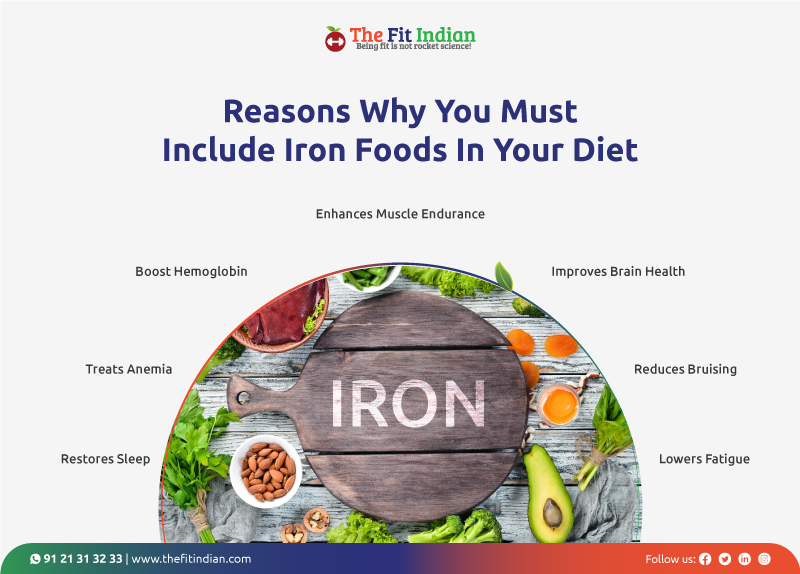 Here are the 7 key reasons why you should take iron-rich foods:
Here are the 7 key reasons why you should take iron-rich foods:
- Boost Hemoglobin
- Lowers Fatigue
- Treats Anemia
- Enhances Muscle Endurance
- Restores Sleep
- Reduces Bruising
- Improves Brain Health
Iron Rich Diet Plan
The Iron Rich Diet Plan includes a variety of plant and animal-based iron-rich foods and vitamin C foods to boost iron absorption in three or four daily meals, including snacks.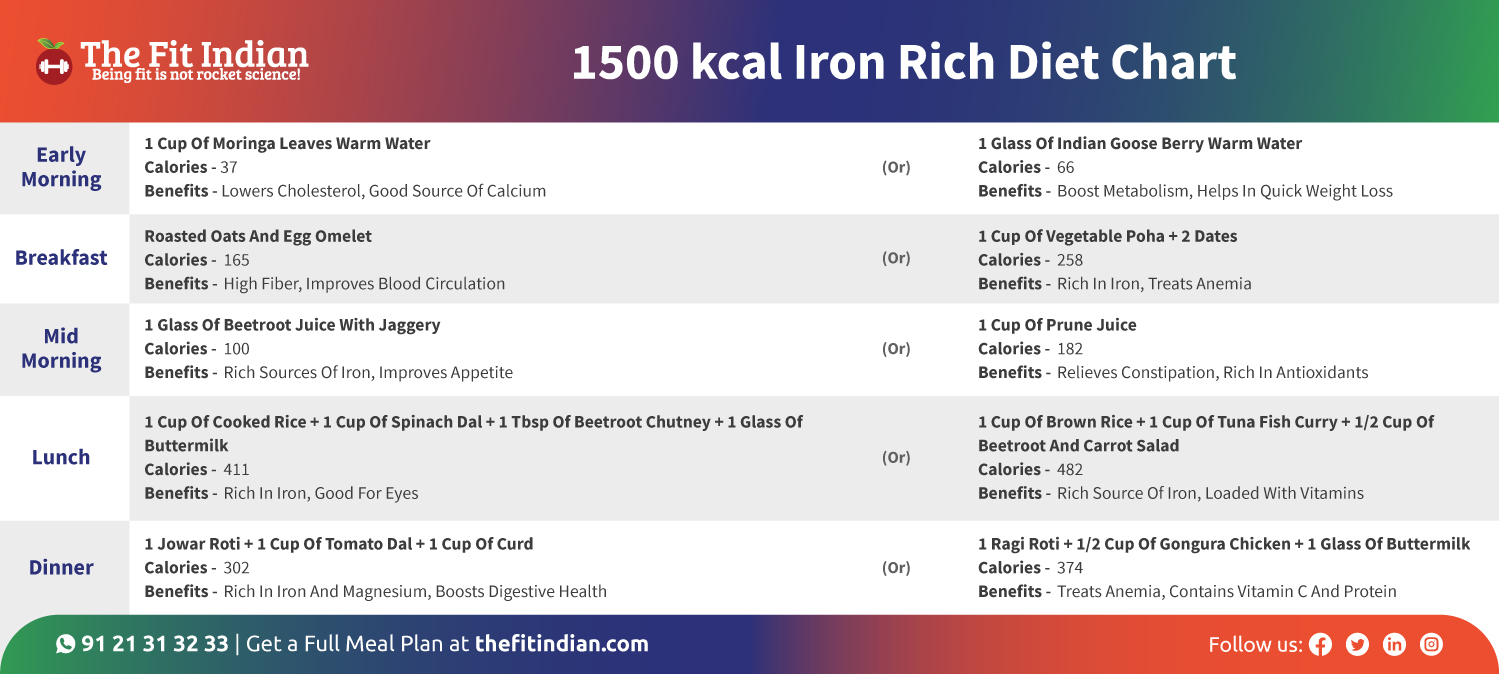 All foods listed in this meal plan for iron deficiency anemia are easily accessible in the local market.
All foods listed in this meal plan for iron deficiency anemia are easily accessible in the local market.
Foods to Avoid If You Have Iron Deficiency
If you have an iron deficiency and are following this diet plan to recover from anemia, you can avoid these foods and drinks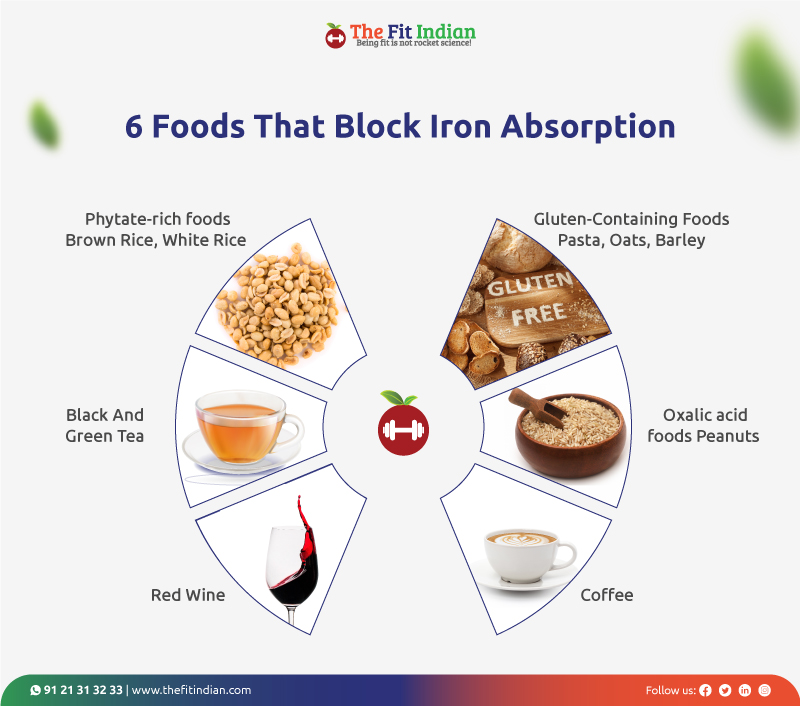
- Red Wine
- Coffee
- Black And Green Tea
- Gluten-Containing Foods – Pasta, Oats, Barley
- Phytate-rich foods – Brown Rice, White Rice
- Oxalic acid foods – Peanuts
Do’s and Don’ts When Following an Iron Deficiency Anemia Diet Plan
While eating iron-rich foods, make sure to follow the tips, including: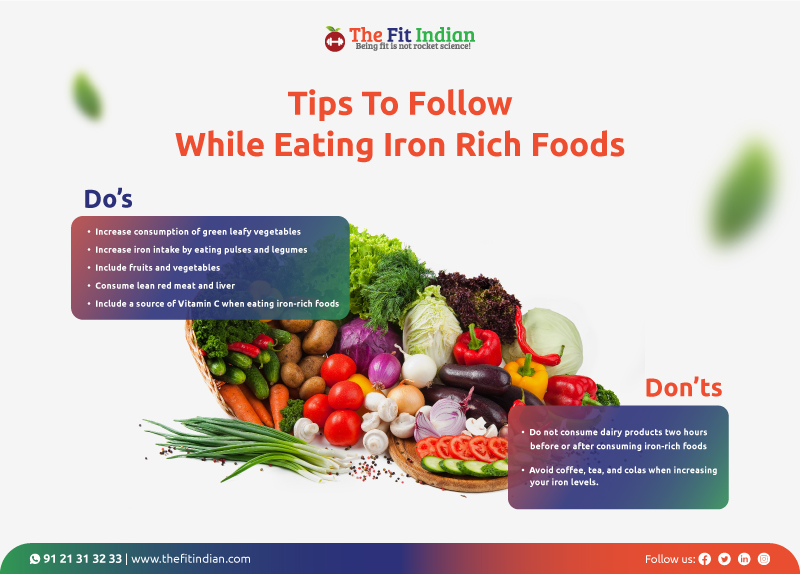 Do’s:
Do’s:
- Increase your consumption of green leafy vegetables
- Increase your iron intake by eating pulses and legumes
- Include fruits and vegetables
- Consume lean red meat and liver, which are high in iron and easily absorbed
- Include a source of Vitamin C when eating iron-rich foods. Iron absorption is aided by vitamin C
- Do not consume dairy products two hours before or after consuming iron-rich foods
- Avoid coffee, tea, and colas when increasing your iron levels.
Our Take
Iron, as one of the essential trace minerals, has an impact on your health and well-being. As our body cannot provide crucial minerals on its own, particularly iron, it is critical to include enough iron-dense foods in one’s diet to avoid iron deficiency, anemia, and other health problems.FAQ’s
1. What foods are rich in iron? Iron helps prevent anemia and keep your body healthy. Here’s a handy list of iron-rich foods to help you get more iron into your diet.- Dried or canned peas and beans
- Lentils
- Bran cereal
- Cornmeal
- Oat cereal
- Dates
- Raisins
- Beef
- Chicken
- Clams
- Eggs
- Dark Greens
- Lentils
- Chicken
- Turkey
- Quinoa
- Pistachios
- Pumpkin seeds
- Sesame seeds
- Flax seeds
- Almonds
- Cashews
- Pine nuts
- Macadamia nuts
Manoja. K is a Post Graduate in Organic Chemistry and has a BSc degree in Clinical Nutrition and Dietetics (Osmania university). She has over 8 years of experience in diet planning, nutrition, and fitness. Her expertise lies in health-related issues such as weight management, PCOD, thyroid, obesity, and stress. She is the chief adviser and full-time contributor at Fit Indian and has the final say on all the segments under the Fit Indian paradigm. She firmly believes that “Good health is a choice”, she believes that a day must begin with nutritious food and fitness activity that helps you beat stress and make life easier. We are not just all about fitness plans; you can also get customized diet plans and healthy cooking tips here! Book a consultation now!

Latest Posts
- Diet Food for Weight Loss – How to Get into Shape Without Comprising Flavor
- Excessive Burping – 10 Reasons and Remedies to Consider
- Evaluating the Correlation Between Intermittent Fasting and Heart Health
- The Importance of Iron-Rich Foods – The Best Sources of Iron in Indian Cuisine
- Can Lifestyle Modification for Obesity Only Help Prevent Obesity?
- Understanding the Health Benefits of Low Glycemic Foods
- Vegan Diet – Benefits, Meal Plan and Recipes
- Exercise and Diet Correlation in Weight Management – A Complete Guide
- How To Boost Your Immunity Against Common Cold With Food
- Calorie Deficit Diet Plan – A Guide to Sustainable Weight Loss



Manoja Kalakanti